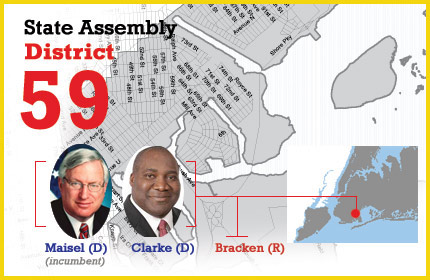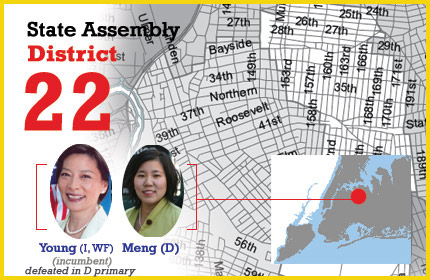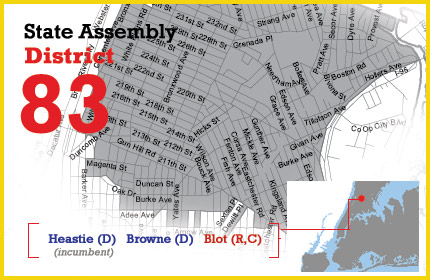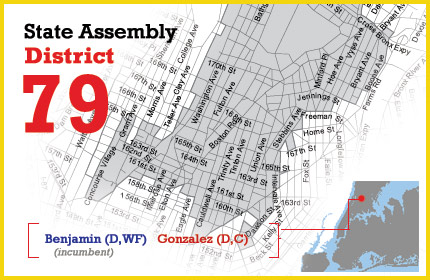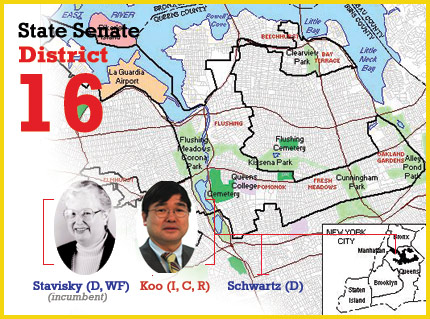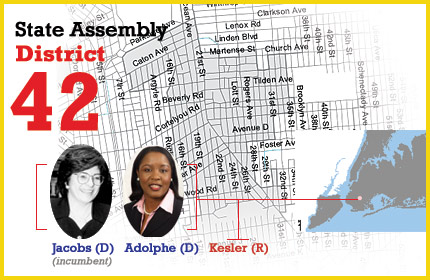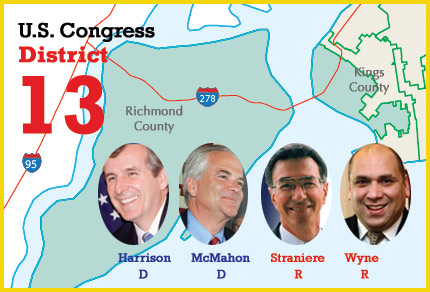Like clockwork, about every five minutes a black garbage truck rumbled down Washington Square South flashing a banner that bashed the Bloomberg administration.
Accompanying a caricature of a puny-looking Mayor Michael Bloomberg was the phrase: “Mayor Mike Only Cares About His Rich Developer Friends."
Harsh, but many community activists at a recent rally believed it.
Condominium high-rises sprout like weeds along the East River waterfront in Williamsburg. Longtime Harlem residents watch newcomers -- often young, affluent and white -- sink into the overstuffed couches of the new cafes and coffee shops along 125th Street, the main street of Black America. Owners of small businesses on the dirt and pothole-ridden streets of Willets Point worry they will lose their location, their customers and their livelihood.
All of these changes represent the new New York, one that has shifted from industrial and manufacturing to finance and services. To accommodate that shift and the population growth that has occurred with it, the Bloomberg administration has rezoned one sixth of the total land in the five boroughs -- more than the last six administrations combined, Bloomberg said during his State of the City address earlier this year. Of the more than 84 rezonings, the City Council has not rejected a single one.
Such impressive numbers, though, conceal a growing unease in many parts of New York. Advocates in some neighborhoods fear the administration is fueling gentrification by giving developers a relatively free hand in working class neighborhoods, while simultaneously protecting more affluent areas from larger-scale development.
Many people in affected communities claim they haven't been a part of the process -- their voices are left out on the policy fringe, teetering on the edge of irrelevance. In response, some planners and politicians hope to boost the community's role in the land use process.
A Changing Landscape
The gutted warehouses of the Williamsburg waterfront -- their chipped paint and cracked windows -- offer a reminder of New York's manufacturing pastime when a million-plus jobs were classified as "industrial." That hovers around a measly 250,000 now.
Our population figures, though, are just the opposite. Since 2000, the city has grown by more than 200,000 people -- many of them flocking to work in what has been a booming service-based economy. But while the city's demographics and economics changed over the decades, its basic parameters did not.
The city had not looked at its zoning regulations since the 1960s. As a result, areas slated for manufacturing lay abandoned, while out-of-scale structures popped up throughout residential neighborhoods that had no restrictions on the size of certain buildings. Builders could sandwich a modern, boxy condominium building eight or ten stories high between 19th-century row houses.
"New York has really struggled to find its way from industrial city to post industrial," said John Kriskiewicz, an architectural historian, while taking a stroll through Williamsburg's industrial waterfront recently. The abandoned Domino Sugar Factory -- which is also slated to be condominiums in the near future -- served as an appropriate backdrop to his critique. "One of the solutions is to rezone formerly industrial neighborhoods," he said.
Partly in the name of sustainability, the administration took on a massive overhaul of city zoning regulations, tackling scores of neighborhoods and about 6,500 blocks. Fifteen initiatives are still slowly going through the Department of City Planning. Generally, zoning regulates what can and what cannot be built in certain areas, depending on use. It also determines how large certain buildings can be. Upzoning an area increases development, while downzoning seeks to preserve the character of the neighborhood by limiting construction.
Most of the administration's revisions, about 5,000 blocks according to the City Council's Land Use chair, Melinda Katz, were for downzonings -- designations to limit height and bulk.
In other areas, the city has sought to spur development, such as high-rise condominiums and large mixed-use structures. Sandy Hornick, deputy executive director for strategic planning for the Department of City Planning, said the city looked for areas with good transit access that had the potential to provide new residences and services for our growing population.
The results included upzonings in Williamsburg and Greenpoint, Harlem and Jamaica and others. Neighborhoods like Clinton Hill or Riverdale, Bay Ridge and Richmond Hill have seen some development protection.
Not surprisingly, some people have opposed the changes.
Clashing Interests
A large crowd, as diverse as the neighborhood, gathered in front of a New York University building earlier this month, while the City Planning Commission heard hours upon hours of testimony inside. At issue: the proposed rezoning of the Lower East Side and East Village. If adopted, this would be the 85th rezoning approved by the city since Bloomberg took over the reins at City Hall in 2002.
Residents and activists assailed city officials.
"They want to make it an island of rich people," said Tosh Anderson, an activist who is member of the Coalition to Protect Chinatown and the Lower East Side.
Though the plan is contentious -- dozens of activists, residents and even a City Council member have sharply criticized it -- it seems highly unlikely this project will be rejected. The City Council has approved every one of the 84 rezonings that have gone through the uniform land use review procedure (the official process that takes a proposal from a community board to borough president to the City Planning Commission to the City Council) since 2002.
Pointing to this fact, activists across the city say the administration and community representatives neglect residents' needs to make way for profitable development.
"Communities claim that I got upzoned and I'm a working class neighborhood and other areas got downzoned, because they have more political clout," said Vicki Been, director of the Furman Center for Real Estate and Urban Policy.
For instance, despite the vocal and apparent opposition to the Lower East Side rezoning, including a commitment from Councilmember Alan Gerson to deny the proposal as is, the area's community board has conditionally approved the proposal.
City officials, on the other hand, attribute their success to a broad based communication effort that starts well before a proposal meets its up or down vote at the City Council. Hornick said the city starts formulating a rezoning proposal with the community in mind.
Who's Being Served?
Key to any discussion about the rezoning lies a debate about who benefits from the city's development strategies. Advocates question whether the administration's policy helps current residents or more affluent newcomers.
Take the Jamaica Plan, the largest rezoning the city ever embarked upon (See related slideshow). Even though it was approved by the City Council last September, Steve Konigsberg, the zoning chair for Community Board 8 in Queens, said his board unanimously rejected the plan, because it feared the area could not handle the extra residents nor the stress it would put on police, transportation and schools.
Though the city is required to disclose in an environmental impact statement what effects the development could bring -- from overloading public transportation to overcrowding public schools -- it is not required to respond to it.
Councilmember David Yassky, who represents much of the Greenpoint-Williamsburg rezoning area, said his district's infrastructure is not prepared for the thousands more residents that could soon call the area home. Though another bus route was proposed, it has since been dropped by the Metropolitan Transportation Authority.
"The mayor has proposed and the council has approved a great deal of development," said Yassky. "One question that goes along with this is: What about all of the infrastructure that should be going along with this?"
Yassky and several planning advocates hope to answer that. The council member is currently working on a proposal that would aim to ensure any development be accompanied by the needed infrastructure.
The Community's Role
Rezonings can come in several ways. There are developer-initiated applications, like Atlantic Yards, but the vast majority begin at the city's planning department.
When the city proposes a rezoning, the community can get involved in myriad ways. On the grassroots level, community boards get to weigh in on zoning proposals. Their recommendations, approval or disapproval are nonbinding and completely advisory. The borough president, whose opinion also is nonbinding, looks at the application too.
For an application to move forward, however, the City Planning Commission (chaired by the head of the city planning department, Amanda Burden) must approve the project. It then heads to the City Council for a final vote.
During the latest round of rezonings, community boards affected by the rezonings have rejected only five: Williamsburg, Downtown Brooklyn, Ladies' Mile in Manhattan, West Chelsea and the Jamaica Plan (the largest rezoning the city has ever done).
All of those developments were adopted by the City Planning Commission and the City Council anyway -- sometimes incorporating the board's suggestions, sometimes not. Of the 84 rezonings approved by the council, 20 percent of community boards included conditions and recommendations within their approvals. While city planning documents contend the commission considered these recommendations, many times they are not adopted.
Take Harlem for instance. Community Board 10 requested height limits on 125th Street at 160 feet. After a compromise between the planning commission and the City Council those buildings are slated to cap at 195 feet. The board suggested increasing affordable housing within private developments from 20 percent to 30 percent -- housing that would not be guaranteed and provided based on an incentive-based proposal for private developers. The commission rejected that proposal.
While City Council and the planning commission modified the 125th Street rezoning several times to address community concerns, many residents still feel silenced . They fear luxury condominium developers will change the demographics of the neighborhood and kick them out.
"If we're talking about public policy, you need to provide for the majority needs of the community, not for the minority needs coming in," said Nellie Bailey, the founding member of the Harlem Tenants Council and a fierce opponent of the approved rezoning.
The City Council Steps In, Or Not?
The City Council has the final say on land use decisions in the city -- one of its very few real powers. Even though it has the capacity to amend and rework rezonings, it more often than not sides with the planning commission.
A review of the zoning decisions since 2002 shows the council has modified an application 19 times, or in about 23 percent of all applications. Not all rezonings warrant revisions -- a lot of the proposals are not controversial and originated with the community. Also, city officials note, disagreements between communities and the city are often worked out before the application gets near the council's land use or zoning committees.
But Councilmember Tony Avella, who chairs the council's zoning committee, said the council often goes along with the mayor's pro-development agenda and does not take enough initiative to amend applications based on community needs.
"Right now, it's from the top down. The administration and the city planning determine the zoning," said Avella. "I want it to be from the bottom up."
The council has modified some of the more controversial rezonings, including the Jamaica Plan, the 125th Street rezoning and the zoning of Williamsburg and Greenpoint.
Katz, the land use committee chair, disagrees that the council always sides with the administration. She said she often visits communities long before the rezoning coming to her desk, in an attempt to hear community concerns. This is necessary, Katz said, because the council has only 50 days after a zoning plan is certified by the City Planning Commission to hold hearings and decide its fate.
This approval trend could be on the verge of shifting, however. Typically when deciding whether to approve or reject a proposal, City Council defers to the member whose district includes the zoning. While it's not uncommon for members to flirt with rejection as a negotiating tactic, generally those involved reach a compromise.
Willets Point, a large scale mixed use development slated for an area currently dominated by auto body and scrap metal businesses, has generated opposition from a majority of council members, including Hiram Monserrate, who represents the district. This is largely due to the project's proposed use of eminent domain to seize local businesses.
This proposal has the potential to taint the administration's winning streak. It is likely to go to the council this fall.
A Community Response
Many advocates and planners see the city's system as having the potential to include more grassroots, community participation. It just needs to be encouraged, they contend.
One approach said Eve Baron, the director of the planning center at the Municipal Arts Society and a member of the Community Based Planning Task Force, would involve providing resources to community boards and groups so they could draft their own planning documents -- otherwise known as a 197-a plan. The document can act as a master plan for the community.
"When we’re talking about public participation, sitting down and being willing to talk before rezoning happens is one thing," said Baron. "There is another thing that is working with the community beforehand to create proactive plans."
The plans, however, are nonbinding and have no force of law (one official said they do nothing but collect "dust"). The plans can also be expensive to produce -- estimates range from $50,000 to $200,000.
Baron said her coalition hopes to draft legislation that will link these community efforts with the city's initiatives to give New Yorkers more of a voice in the land use process. That proposal could include giving every community board its own planner, said community advocates.
Most experts, including Been of the Furman Center, do not think communities should have veto power -- most agree the city would then have no waste transfer stations or other controversial necessities. But they do want residents to have more clout and be able to provide their vision before the city tells a community what it will look like in the future.
Along with that, community planners are pushing for a more comprehensive approach to zoning. They are encouraging officials to not look at the city neighborhood by neighborhood, but instead as a whole -- recognizing how one development may affect another.
"I think what we need is a comprehensive citywide plan or planning framework," said Baron. "I think we just need to have that conversation as a city."
Â

